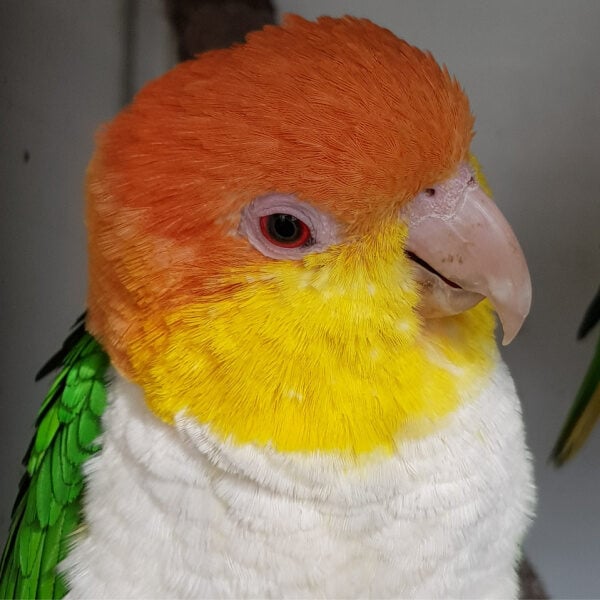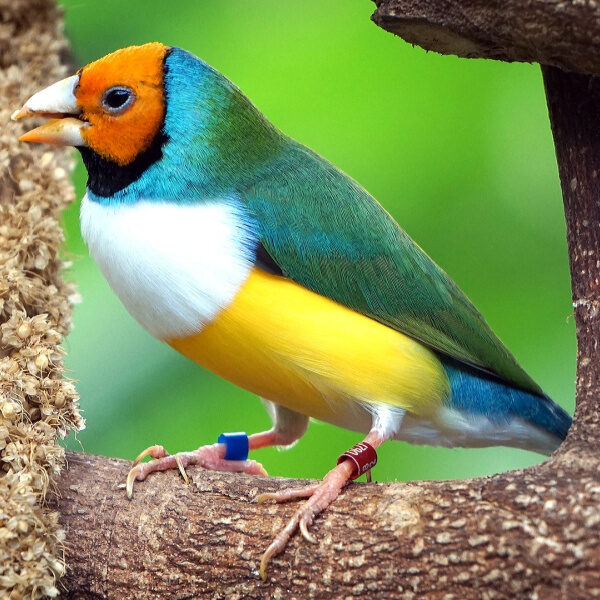Last Updated on by Mitch Rezman
Marie A. reached out:
HELP!!!!!!
I have a real problem and need to fix it asap – doing what is best for both birds ……
I purchased what I hoped was a male for my pink eyed yellow female Flash.
“Tiki” turned out to be a female and right about that time I had to move in with my elderly mother who had 2 back fractures and the birds came with me.
I also have another bonded pair male/female but the male is very old and past breeding age.
Then I have a 20-year-old female Sun Conure.
It has been a difficult time, to say the least, and my mother’s days are numbered.
I was unable to separate the 2 females during this time period and now Flash has taken the dominant role and has been breeding with Tiki (both are females) and now Tiki has started laying eggs.
She was very young when I got her so she knows nothing else.
I am removing the eggs from the cage as she lays them. She is laying in a protected area under the water dish. When would the best time to introduce a male to each of them?
Should I separate them? I don’t want lesbian budgies and unfortunately, the turn of events with my mother took priority. I do plan to raise birds once I relocate.
Thank you for your advice!!!!
Embarrassed Marie in Virginia.
Dear Marie
Relax, all is well and this CAN be resolved.
Birds have no definite concepts regarding sexuality. They are capable of developing relationships with either a male or a female bird.
They just want someone to love and be with. That drives us all.
Externally they all have the same body parts and all they are doing is rubbing them together.
If a real pair, the male rubs his extended cloaca against hers but he has sperm on his. After rubbing them together, they close back up and the sperm is used to fertilize her eggs.
In captivity (and sometimes even in the wild) birds of the same sex can pair up with one bird taking on the role as the male and the other as the female.
If both females, one or both can start laying if stimulated mentally.
So your nest could have “infertile” eggs from both birds or just the one.
At any time you can separate them and put them with males.
Once they get new attention from their new boyfriends they will forget all about their little girl flings.
To keep them and any other birds from egg-laying and mating when you don’t want them to you need to get their cage lighting under control with strong lights above their cages set on timers 12 hours on and 12 hours off.
Here’s How Pet Bird Keepers Get The Lighting Thing Wrong – light therapy instructions.
Budgies, conures, all tropical birds are from tropical areas where the sun blazes down 12 hours.
When winter sets in the sun is not as bright for the whole 12 hours and is now dimmer for more than 12 hours so they start thinking about building nests, mating, and raising a family.
That is how it feels while in our dim homes.
Windows, table lamps, ceiling lights in our homes all contribute to the nesting, pairing up, broody behavior that you see in your budgies now.
This bulb screwed into a fixture placed directly above (as close as possible) on top of the cage shining down onto the birds will slowly regulate their hormones.
It takes about 30 days to notice a difference.
Full Spectrum Economy
Daylight Bulb with Clamp Light & Timer
If they are chronically laying you can stop this by giving them a 72 hour light treatment.
What you would do is put the light over their cage.
But instead of 12 hours on and 12 hours off, you leave the light on for 72 hours.
That is 3 days AND nights where the light is left ON.
This resets the Cirdadium Rhythm in their brain which is affected through their eyes (the pineal gland).
After the 3 days and nights (72 hours), in which they will eat, sleep, play as usual in the full light except they may nap and call out during odd hours (not a problem).
Then you will find that they will lose interest in their eggs and mating.
Toss the eggs now.
Get the lighting set up. If you do this you will see them return to being playful birds.
I recommend the lighting done as a daily thing year-round unless you are trying to get eggs, etc.
Then you can turn them off or set the timer so they get 8-10 hours of bright light only with the rest being dimmer.
This is our lighting section.
You can find bulbs and numerous lamps to consider.
Please let me know if I can help further.
Kindest regards
Catherine
Author Profile
Latest entries
 The Traveling BirdJune 26, 2025Can You Name 5 Parrot Species That Are Living Wild in the USA?
The Traveling BirdJune 26, 2025Can You Name 5 Parrot Species That Are Living Wild in the USA? Bird BehaviorJune 26, 2025How is it Parrots Are Problem Solvers Social Animals and Even Use Tools?
Bird BehaviorJune 26, 2025How is it Parrots Are Problem Solvers Social Animals and Even Use Tools? Bird & Parrot AnatomyJune 25, 2025How a Tiny Chemical Modification Makes Parrots Nature’s Living Paintings
Bird & Parrot AnatomyJune 25, 2025How a Tiny Chemical Modification Makes Parrots Nature’s Living Paintings PigeonsJune 20, 2025How Do Parrots Thrive in Cities Outside Their Native Habitats?
PigeonsJune 20, 2025How Do Parrots Thrive in Cities Outside Their Native Habitats?






